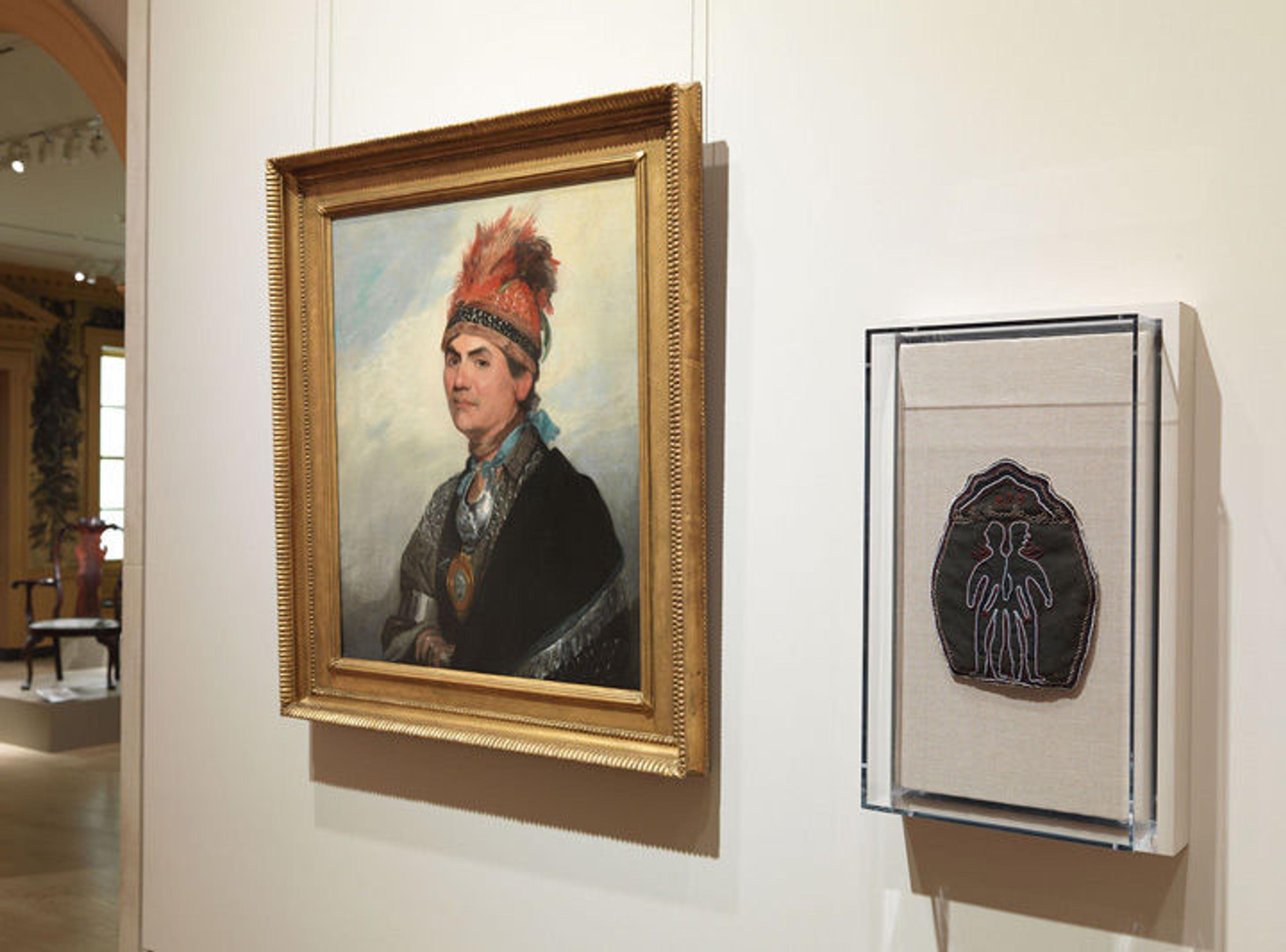
Gallery 760 in The American Wing
«A few months ago, three extraordinary Native American artworks from the Charles and Valerie Diker Collection were installed in the galleries of the The American Wing. Complementing the concurrent exhibition on the other side of the building, Native American Masterpieces from the Charles and Valerie Diker Collection, on view through March 19, these objects are displayed with related American paintings and sculptures that offer broader historical and cultural contexts for understanding them. At the end of 2016, the Dikers generously converted the loaned items—which include an Iroquois pouch (gallery 753), a Pomo basket (gallery 760), and a San Ildefonso Pueblo jar (gallery 765)—to designated gifts.»

The exceedingly rare early 19th-century pouch was fabricated from wool that resembles smoke-dyed buckskin, suggesting the hybrid nature of Native production during this period—blending European materials with indigenous imagery. Its innovative ornament is executed in beaded seed-glass embroidery. On the front is a conventional floral decoration and, on the back, the raised flap forms a composition that represents the sacred conjoined twins—key figures in the legends of New York's Iroquois, or Haudenosaunee, the historically powerful Native American confederacy of Mohawk, Oneida, Onondaga, Cayuga, Seneca, and, later, Tuscarora nations.
Left: The Iroqois pouch installed in gallery 753
According to Ruth Phillips, a specialist in Native American art at Carleton University, the style of the innovative design appears to be Seneca. She also notes the pouch's significance as possibly the first visual depiction of Seneca oral teaching and sacred stories following the trauma and breakup of the Haudenosaunee Confederacy during the American Revolution.
This compelling object is displayed near a 1786 painting by the American artist Gilbert Stuart (1755–1828), Mohawk Chief Thayendanegea, Known as Joseph Brant. The portrait, one of the finest Stuart ever painted, is a promised gift to The Met from an anonymous donor in honor of Annette de la Renta. A revered Iroquois statesman, Thayendanege tirelessly lobbied both British and American authorities, including King George III and George Washington, for his people's survival. Commissioned by his close friend Hugh, Earl Percy, later the Second Duke of Northumberland, the portrait marks a fraternal bond that crossed racial, cultural, and national identities.

View of gallery 753 showing Gilbert Stuart's Mohawk Chief Thayendanegea, Known as Joseph Brant and the Iroquois pouch
The Pomo Indians of northern California have long been celebrated for their extraordinary artistry in basket weaving. An outstanding example from around 1890 is displayed near the recently acquired Dance in a Subterranean Roundhouse at Clear Lake, California, a painting of 1878 by Jules Tavernier (1844–1889). That dramatic image represents a sacred coming-of-age ceremony in an underground Pomo roundhouse, one in which a basket is prominently featured in the foreground.
The Pomos, once-isolated groups of people who spoke different languages and numbered in the thousands, lived off the bounty of the land in a region north of San Francisco. The handsome basket from the Diker Collection is made of sedge root and redbud shoots on a willow foundation, materials gathered from the Pomo's annual harvest that were first dried, then plaited and coiled.

View of gallery 760 showing Jules Tavernier's Dance in a Subterranean Roundhouse at Clear Lake, California and the Pomo basket
Made by both women and men, such baskets were used for utilitarian and ceremonial purposes as well as in decorating lodges (as seen in the Tavernier painting) and gift giving. Beginning in the 1870s, these baskets became very popular with Anglo-Americans—a collecting craze that lasted through the 1920s and represented a new livelihood for the tribe. While greatly reduced in number today, Pomo basket makers are still revered for their sacred artistic practice.
Maria Martinez (1887–1980) and her husband, Julian Martinez (ca. 1885–1943)—Tewa Indians of the San Ildefonso Pueblo in New Mexico—are among the most widely acclaimed 20th-century American potters. Inspired by archaeologists working at what is now known as Bandelier National Monument, Maria led a revival of ancient pottery styles among pueblo artisans. After establishing a national reputation at the 1904 St. Louis World's Fair, Maria began collaborating with her husband. Between 1919 and 1943, she shaped the pots and Julian painted the designs—the first acknowledged male artist of their pueblo to do so.

View of Maria Martinez's olla installed in gallery 765 between Ernest Blumenschein's Taos Valley, New Mexico and Frederic Remington's On the Southern Plains
The olla, or jar, from the Diker Collection was made around 1919–20 and is an outstanding example of the Martinezes' early collaborative work. The vessel is based on ancient forms, updated with aesthetic and formal innovations. Its matte black-on-black surface represents the culmination of 10 years of experimentation with firings and materials. Julian used a mixture of clay and beeweed for the iconographic decoration, which represents Avanyu, a Tewa deity and guardian of water. The jar is displayed among paintings and sculpture—by Albert Bierstadt, Ernest Blumenschein, and Frederic Remington, among others—that depict the American west, both real and imagined, and its iconic presence in our national culture.
Featuring Native American art in The American Wing for the very first time in The Met's history reveals our current commitment to expanding the definition and scope of American art at the Museum, now and in the future. I hope you'll let us know what you think about that direction, which we find very exciting.
Related Links
Native American Masterpieces from the Charles and Valerie Diker Collection, on view at The Met Fifth Avenue through March 19, 2017
MetCollects—Episode 7 / 2016: "Jules Tavernier's Dance in a Subterranean Roundhouse"